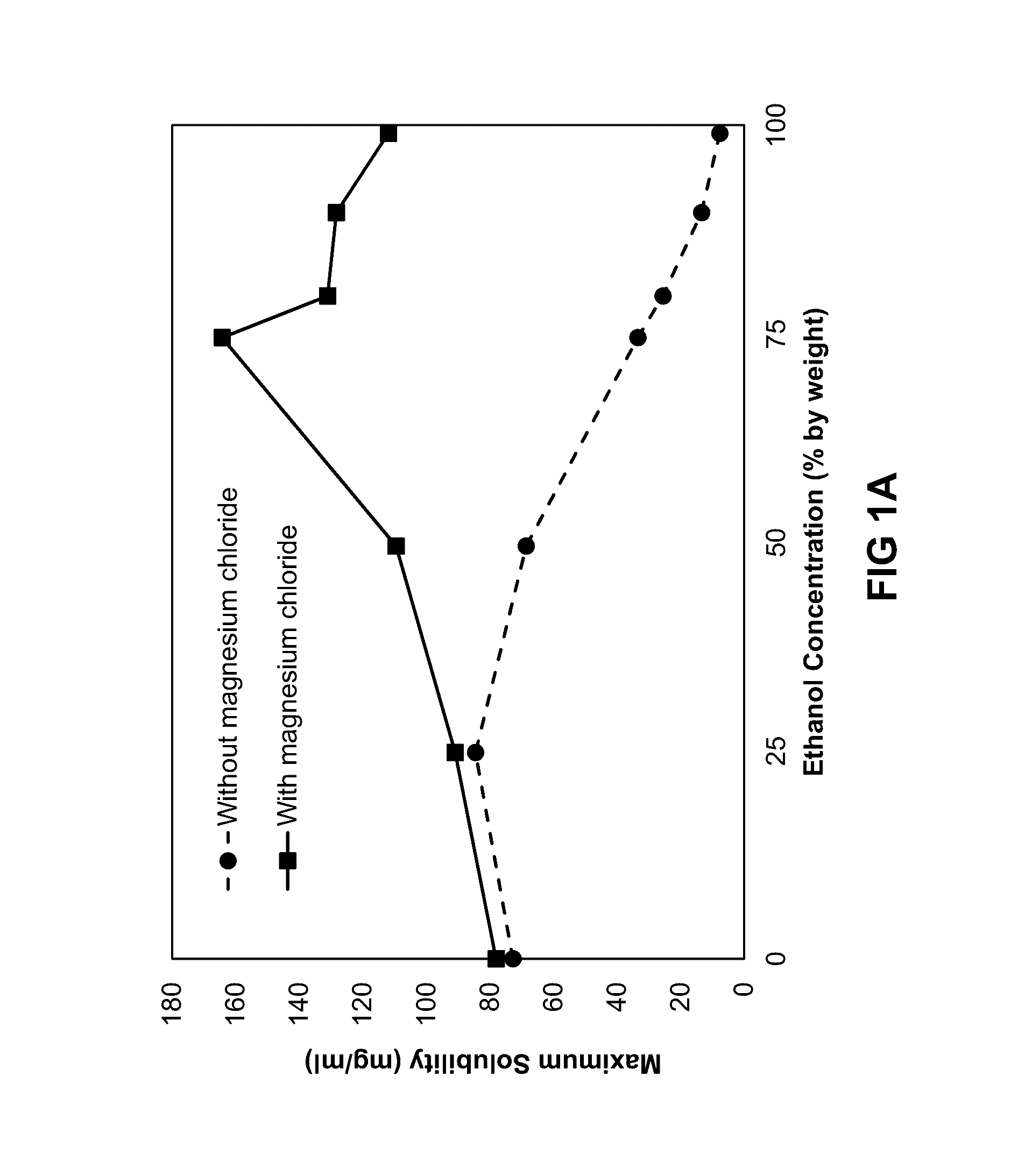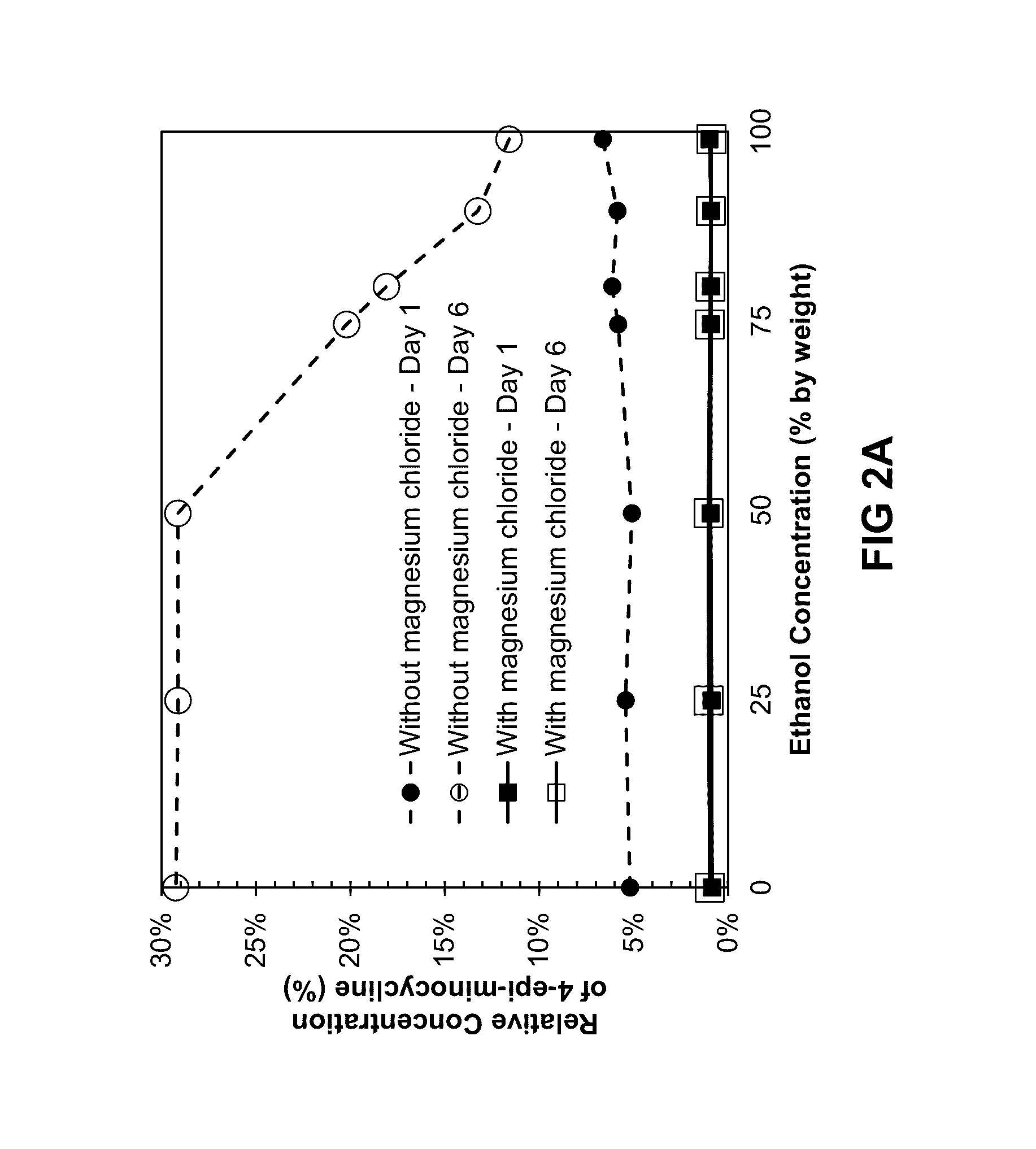Pharmaceutical tetracycline composition for dermatological use
a technology of dermatological use and composition, applied in the field of pharmaceutical compositions, can solve the problems of systemic delivery of tetracycline-class drugs accompanied by adverse side effects, diarrhea, abdominal cramps, and dizziness, and achieve the effect of preventing skin scaling
- Summary
- Abstract
- Description
- Claims
- Application Information
AI Technical Summary
Benefits of technology
Problems solved by technology
Method used
Image
Examples
example 1
Solubility of Minocycline and Magnesium-Stabilized Minocycline
[0191]A study was performed to assess the effect of magnesium chloride (MgCl2) on the solubility of minocycline in mixtures of ethanol and propylene glycol. Mixtures of ethanol (Spectrum Chemicals, Gardena, Calif.), propylene glycol (Spectrum Chemicals, Gardena, Calif.), and 1,8-cineole (Penta International Company, Livingston, N.J.) were prepared as described in Table 1. The compositions correspond to the following approximate ratios by weight of ethanol and propylene glycol: 0:1, 1:3, 1:1, 3:1, 4:1, 9:1, and 1:0.
TABLE 1MIXTURES FOR SOLUBILITY EXPERIMENTS WITHVARYING AMOUNTS OF MAGNESIUM CHLORIDEPROPYLENE1,8-SAMPLEETHANOLGLYCOLCINEOLEDESIGNATION(% W / W)(% W / W)(% W / W)TEST MATERIAL100-MNC9901Minocycline*HCl90-MNC89.59.51Minocycline*HCl80-MNC79.519.51Minocycline*HCl75-MNC74.524.51Minocycline*HCl50-MNC49.549.51Minocycline*HCl25-MNC24.574.51Minocycline*HCl0-MNC0991Minocycline*HCl100-Mg9901Minocycline*HCl—MgCl290-Mg89.59.51Mino...
example 2
DSC Measurements
[0198]This experiment was performed to assess whether there was a difference in the melting point for a mixture of minocycline hydrochloride, magnesium chloride, ethanol, and propylene glycol relative to the individual melting points of minocycline hydrochloride and magnesium chloride.
[0199]A test mixture of minocycline hydrochloride (Euticals S.P.A, Origgio, Italy) with magnesium chloride (Sigma-Aldrich Corp., St. Louis, Mo.) in a 1:1 ratio (w / w) was prepared by blending in a vortex mixer (VORTEX GENIE, Scientific Industries, Inc. Bohemia, N.Y.) at approximately 3000 rpm until obtaining a uniform mixture or for at least 3 minutes. The dry mixture was placed into a ceramic mortar and manually agitated with stainless steel spatula while a solution consisting of ethanol (Spectrum Chemicals, Gardena, Calif.), and propylene glycol (Spectrum Chemicals, Gardena, Calif.) in a 3:1 ratio (w / w) was added drop wise to uniformly wet the mixture. The wet sample was then gently mi...
example 3
Stability of Minocycline and Magnesium-Stabilized Minocycline
[0203]The effect of component contributions to drug potency stability and epimer formation for illustrative mixtures of minocycline hydrochloride, magnesium chloride, ethanol, and propylene glycol was assessed using the compositions described in Example 1.
[0204]The degradation and stability of minocycline in compositions were measured at Day 1 and Day 6 following storage in the dark at room temperature conditions within sealed glass vials.
[0205]In Table 2, the formation of 4-epi-minocycline was extrapolated to a period of 18 months. The extrapolation calculation assumed that the degradation mechanisms continue at the same mathematical rate as for days 1-6. This represents a worst case value and does not take into account the fact that 4-epi-minocycline may reach equilibrium with minocycline within the composition, such that the extremely high levels of 4-epi-minocycline, such as 99.76% and 100%, may not represent a physica...
PUM
| Property | Measurement | Unit |
|---|---|---|
| Temperature | aaaaa | aaaaa |
| Temperature | aaaaa | aaaaa |
| Fraction | aaaaa | aaaaa |
Abstract
Description
Claims
Application Information
 Login to View More
Login to View More - R&D
- Intellectual Property
- Life Sciences
- Materials
- Tech Scout
- Unparalleled Data Quality
- Higher Quality Content
- 60% Fewer Hallucinations
Browse by: Latest US Patents, China's latest patents, Technical Efficacy Thesaurus, Application Domain, Technology Topic, Popular Technical Reports.
© 2025 PatSnap. All rights reserved.Legal|Privacy policy|Modern Slavery Act Transparency Statement|Sitemap|About US| Contact US: help@patsnap.com



